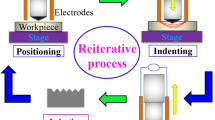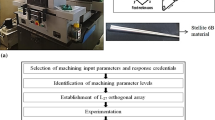Abstract
Micro EDM using conventional pulse generators such as the RC type or transistor type with water as the dielectric fluid suffers from poor accuracy of machined structures due to electrolytic corrosion. In this study, a new high frequency bipolar pulse generator for micro EDM in water was developed in order to prevent electrolytic corrosion. The new pulse generator produced a high frequency bipolar pulse possessing a positive pulse duration of several hundred nanoseconds with a high repetition rate provided to the machining gap. Discharge characteristics of micro EDM using the new pulse generator were investigated. Machining characteristics were also investigated according to machining conditions such as the repetition rate, positive voltage, capacitance and resistivity. Using the new pulse generator, micro holes without electrolytic corrosion were successfully fabricated in deionized water and tap water. Machining time, tool wear and clearance using the new pulse generator in deionized water decreased compared with those using the RC circuit in kerosene.
Similar content being viewed by others
References
Kim, B. H., Ryu, S. H., Choi, D. K. and Chu, C. N., “Micro electrochemical milling,” J. Micromech. Microeng., Vol. 15, No. 1, pp. 124–129, 2005.
Shin, H. S., Kim, B. H. and Chu, C. N., “Analysis of the side gap resulting from micro electrochemical machining with a tungsten wire and ultrashort voltage pulses,” J. Micromech. Microeng., Vol. 18, No. 7, Paper No. 075009, 2008.
Yang, I. S., Park, M. S. and Chu, C. N., “Micro ECM with ultrasonic vibrations using a semi-cylindrical tool,” Int. J. Precis. Eng. Manuf., Vol. 10, No. 2, pp. 5–10, 2009.
Chung, D. K., Kim, B. H. and Chu, C. N., “Micro electrical discharge milling using deionized water as a dielectric fluid,” J. Micromech. Microeng., Vol. 17, No. 5, pp. 867–874, 2007.
Jahan, M. P., Wong, Y. S. and Rahman, M., “A Comparative Study of Transistor and RC Pulse Generators for Micro-EDM of Tungsten Carbide,” Int. J. Precis. Eng. Manuf., Vol. 9, No. 4, pp. 3–10, 2008.
Liao, Y. S., Chen, S. T. and Lin, C. S., “Development of a high precision tabletop versatile CNC wire-EDM for making intricate micro parts,” J. Micromech. Microeng., Vol. 15, No. 2, pp. 245–253, 2005.
Rajurkar, K. P., Levy, G., Malshe, A., Sundaram, M. M., McGeough, J., Hu, X., Resnick, R. and DeSilva, A., “Micro and nano machining by electro-physical and chemical processes,” CIRP Annals — Manufacturing Technology, Vol. 55, No. 2, pp. 643–666, 2006.
Chung, D. K., Shin, H. S., Kim, B. H., Park, M. S. and Chu, C. N., “Surface finishing of micro-EDM holes using deionized water,” J. Micromech. Microeng., Vol. 19, No. 4, Paper No. 045025, 2009.
Yamamoto, M. and Magara, T., “Power supply unit electric discharge machining apparatus,” US Patent, No. 5064984, 1991.
Balleys, F., “Process and device for machining by electroerosion,” US Patent, No. 6465754 B1, 2002.
Nakashima, T., Hattori, K., Ukai, Y., Taneda, A., Goto, A. and Hashimoto, T., “Power supply unit for wire electrical discharge machining and method of wire electrical discharge machining,” US Patent, No. 6930273 B2, 2005.
Goto, A., Hattori, K. and Nakamura, K., “Wire electrical discharge machining apparatus,” US Patent, No. 7038158 B2, 2006.
Song, K. Y., Chung, D. K., Park, M. S. and Chu, C. N., “Micro electrical discharge drilling of tungsten carbide using deionized water,” J. Micromech. Microeng., Vol. 19, No. 4, Paper No. 045006, 2009.
Dorf, R. C. and Svoboda, J. A., “Introduction to electric circuits, 5th edition,” John Wiley & Sons, pp. 378–389, 2001.
Uhlmann, E., Piltz, S. and Doll, U., “Machining of micro/miniature dies and moulds by electrical discharge machining-recent development,” J. Mater. Process. Technol., Vol. 167, No. 2–3, pp. 488–493, 2005.
Cho, P. J., “Characteristics of RC circuit with transistor in micro-EDM,” Ph.D. Dissertation, School of Mechanical and Aerospace Engineering, Seoul National University, 2002.
Author information
Authors and Affiliations
Corresponding author
Rights and permissions
About this article
Cite this article
Chung, D.K., Shin, H.S., Park, M.S. et al. Machining characteristics of micro EDM in water using high frequency bipolar pulse. Int. J. Precis. Eng. Manuf. 12, 195–201 (2011). https://doi.org/10.1007/s12541-011-0027-6
Received:
Accepted:
Published:
Issue Date:
DOI: https://doi.org/10.1007/s12541-011-0027-6




